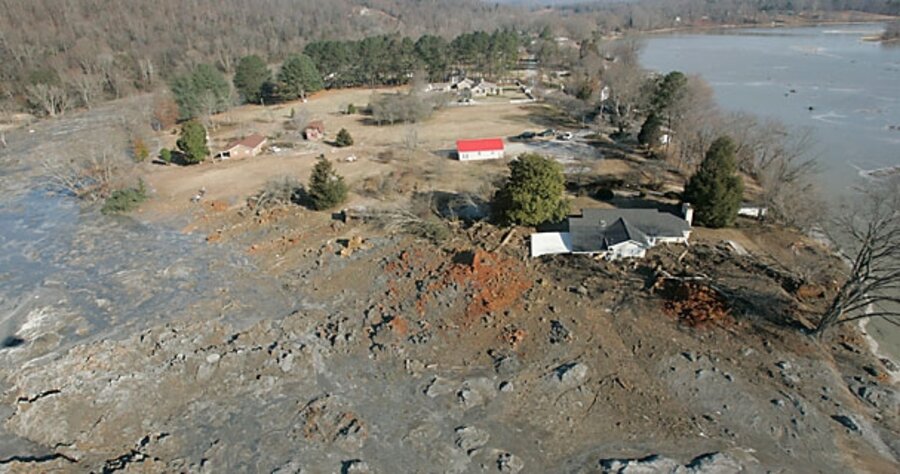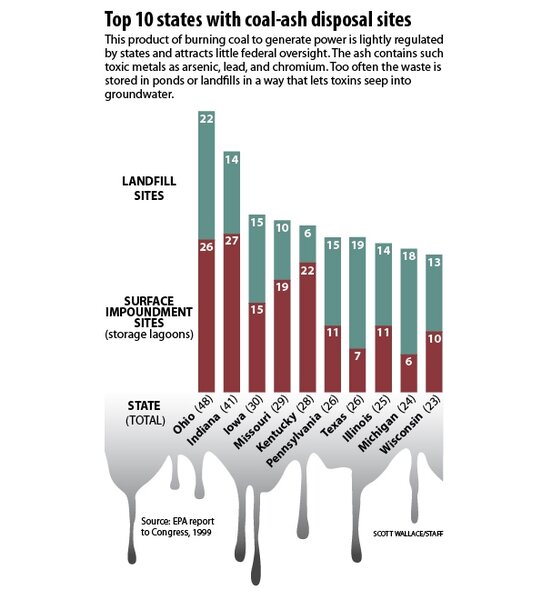Coal-ash waste poses risk across the nation
The billion-gallon wave of toxic coal-ash sludge that burst from a power-plant retention pond and buried 300 acres of rural Tennessee hints at a far larger problem: hundreds of similar threats nationwide.
More than 1,300 coal-ash waste sites are dotted across the United States, about half of them actively used, federal data show. Some are landfills. The rest are “surface impoundments” (storage lagoons), which, like the one in Tennessee, mix ash with water.
Coal ash has some beneficial uses. It can be mixed with concrete to make roads, for example. But storing coal ash in a retention pond – common at coal-fired power plants nationwide – can be a threat to the environment and humans as well: The ash contains many toxic metals, including arsenic, lead, and chromium.
At least 67 coal-ash sites have been found to be damaging drinking-water supplies in communities across 23 states, the US Environmental Protection Agency reported last year. But those EPA-identified sites grossly understate the threat, environmentalists say.
EPA study finds only 13 'safe' coal-ash waste dumps
Among an additional 155 landfill and surface-impoundment sites in 36 states reviewed by the EPA in 2007, all but 13 had no liner or an inadequate clay liner. Most – two-thirds of them – had no liner at all. (An impermeable liner is needed to keep toxic metals from leaching from the ash into groundwater supplies.)
This concerns Kevin Madonna, who, with his law-firm partner, Robert F. Kennedy Jr., keeps a close eye on water-pollution issues. Using last year’s EPA data, Mr. Madonna cross-checked coal-ash lagoons and landfills that had either a clay liner or no liner to see which ones were close to human populations and waterways.
One-third are close to human populations
Of the 155 waste sites, more than one-third were close or very close to significant human populations; two-thirds were near or very near key waterways, Madonna found. About half of the sites were coal-ash surface impoundments (lagoons).
“You have toxic wastes leaking into water bodies from probably every single one of these lagoons,” Madonna says. “It’s a huge mess.”
Little is known about coal-ash storage sites, which are lightly regulated by states and exempt from federal hazardous-waste regulations. Many are decades old, which increases the potential for leakage and containment failure, experts and environmentalists say.
Lisa Evans, an attorney for Earthjustice, an environmental group, says the EPA underestimates the problem. “Most impoundments are not monitored at all,” she says. “The list of sites identified by the EPA in 2007 is far from comprehensive.”
Needed: impermeable liners for waste sites
An earlier EPA report to Congress in 1999 showed that about three-quarters of some 300 active surface impoundment sites were unlined, Ms. Evans says. Of those that were lined, most were probably lined with clay, which is an inadequate barrier to toxic metals and invites contamination oflocal ground water, says Charles Norris. Mr. Norris is head of Geo-Hydro Inc., a Denver-based consulting company that has analyzed the hydrogeology of such structures. An impermeable composite (plastic) liner is what’s required, he and others say.
The problem is perhaps most acute among nearly 100 coal-ash storage lagoons in two dozen states across the country. Many of these ponds are far larger and far more toxic than the one that burst at the Tennessee Valley Authority’s Kingston power plant at Harriman, Tenn., on Dec. 22.
That assertion is based on data released Jan. 7 by the Environmental Integrity Project (EIP), a Washington-based watchdog group. Their analysis of EPA data showed volumes of heavy metals that were larger than those at Kingston being deposited at other power-plant waste sites.
Aresnic, lead pose threat to well water
Arsenic levels in waterways near the Kingston spill were far above safe drinking water standards, according to EPA samples taken after the accident. Such toxins can be removed at water treatment facilities, but pose a threat to drinking water wells,
Some power-plant surface impoundments are 1,500 acres in area and contain perhaps 55 million cubic yards of material. That’s several times the size of the Kingston facility.
Environmentalists say Tennessee a warning sign
“Our analysis confirms that this problem is truly national in scope and that Tennessee may end up only being a warning sign of much more trouble to come,” EIP director Eric Schaeffer said in a statement. He also warned of what he called “inadequate oversight and monitoring of land-based disposal and other ‘storage’ of these toxic wastes.”
Just ask Jan Nona, a retired secretary who lives in the little town of Michigan City, Ind., two miles from a coal-ash landfill that has grown to be several city blocks long, several blocks wide, and a few stories tall. Only part of the landfill is lined, so toxins like boron have leached into the city ground water.
“I used to have a well with sweet water – until the boron level got too high,” she says. “Me and my neighbors have had to give up our wells now that they have boron, manganese, molybdenum, and other things in them. We’ve got test results that boggle the mind.”
Sturdiness of impoundment dams an issue
Others are more concerned about a catastrophic release. In the past eight years, two other big dam breaks have occurred in coal-ash impoundments, one in Georgia and one more recently in Pennsylvania on the Delaware River. Both spills killed river life for miles and cost tens of millions of dollars to clean up.
Just how sturdy are the hundreds of dams holding back hundreds of millions of cubic yards of coal-ash slurry? Many of these dams are made of compacted coal ash, as was the case at the TVA facility, rather than of compacted earth, which is more stable.
But “coal ash is not in equilibrium with the environment,” Geo-Hydro’s Mr. Norris says. “It reacts quite strongly with any water that comes in contact with it. I’ve read the inspection reports from the TVA facility. It’s pretty clear this is material that is internally degrading.” (On January 9, a second spill of waste from a TVA coal-fired power plant came at its Widows Creek facility in northeast Alabama. This time it was not coal ash escaping, TVA officials said, but about 10,000 gallons of gypsum from a cooling-system pond, the Knoxville News Sentinel reported.)
Averting the problem might have cost one-tenth as much as cleanup
At the Kingston facility, TVA officials did not pursue a $25 million proposal to dry out the sludge and ship it to a properly lined landfill, despite evidence that the lagoon dam was weakening, according to published reports. Instead they turned to less-costly alternatives. Would tighter regulation have helped?
Maybe. But in the 28 years since Congress enacted 1980’s Solid Waste Disposal Act and required the EPA to report back on whether to regulate coal combustion waste (CCW), EPA attempts to regulate the material have fallen before vigorous utility industry lobbying, lawyer Evans says.
In 2000, for instance, the EPA determined that CCW did not warrant regulation as hazardous waste. It subsequently cut most funding to develop national regulations and instead began drawing up voluntary guidelines, Evans says.
Since then, however, the EPA has “collected significant new data and new analyses,” says Matthew Hale, director of EPA’s Office of Solid Waste, in a statement responding to Monitor queries. EPA is now analyzing data gathered in its 2007 study, he said, “and will consider this information as we continue to follow up on the regulatory determination on the management of coal combustion waste.”
Utility group says better state regulations will suffice
A utility industry spokesman says it has been joined by many others, including states, to lobby against federal hazardous waste regulation. State regulation is working, despite the Kingston collapse, according to Jim Roewer, executive director of the Utility Solid Waste Activities Group, an industry trade association. “A lot of people are claiming that if coal ash is not regulated as a hazardous waste at the federal level, then it’s not regulated,” he says. “States do have programs, and they aren’t static and have become more stringent over time.... Tennessee and other states will be reviewing their programs” in light of this spill.
Priorities for solving the problem are clear, environmentalists say
But environmentalists say the solution is obvious: Phase out all wet storage of toxic coal ash; immediately inspect and begin monitoring coal-ash storage and disposal units; begin federal regulation of all coal-ash storage and disposal by year’s end.
This daunting problem may be solved by putting coal ash in dry, specially-lined landfills to keep water out. Cleaning up the Kingston spill will cost 10 times what it would have cost to dry and ship the ash to a proper landfill, Evans says. “It’s a problem that has a clear solution,” she says. “We just need to decide to do it.”






